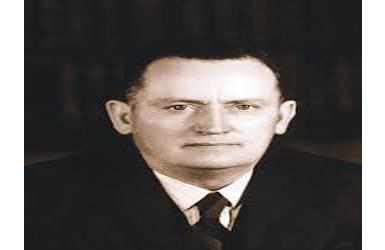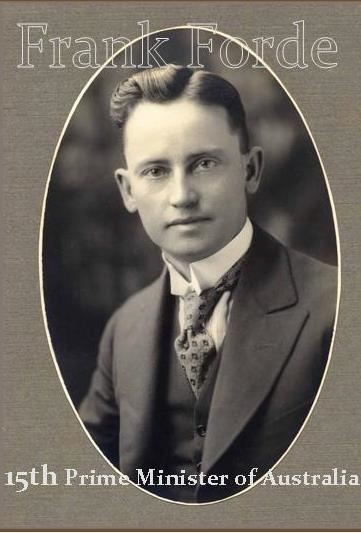Preceded by William Higgs Name Frank Forde | ||
 | ||
Governor-General HRH The Duke of Gloucester Role Former Prime Minister of Australia Previous offices Prime Minister of Australia (1945–1945) | ||
1931 frank forde efftee studio opening
Francis Michael Forde (18 July 1890 – 28 January 1983) was an Australian politician who served as Prime Minister of Australia from 6 to 13 July 1945. He served in a caretaker capacity after the death of John Curtin, and is the shortest-serving prime minister in Australia's history.
Contents
- 1931 frank forde efftee studio opening
- 61 Frank Forde
- Early life
- Political career
- Prime Minister
- Aftermath
- High Commissioner and return to state politics
- After politics
- Family
- References

Forde was born in Mitchell, Queensland, to Irish immigrant parents. He was a schoolteacher in Rockhampton before entering politics. Having joined the Labor Party at a young age, Forde was elected to the Queensland Legislative Assembly in 1917, aged 26. He transferred to the House of Representatives at the 1922 federal election, winning the Division of Capricornia. Forde entered cabinet in 1931, serving as Minister for Trade and Customs for what would be the final year of the Scullin Government.

After Labor's landslide defeat at the 1931 election, Forde was elected deputy leader in place of Ted Theodore. He returned to cabinet in 1941 as Minister for the Army in the Curtin Government, and as the de facto deputy prime minister was one of the government's most prominent figures. When John Curtin died in office in 1945, Forde was appointed prime minister to serve while the Labor Party elected a new leader. He contested the leadership ballot against Ben Chifley and Norman Makin, but Chifley emerged victorious.

Forde continued on as deputy leader and army minister in the Chifley Government, but lost his seat at the 1946 election. He then served as High Commissioner to Canada from 1947 to 1953. Forde attempted to re-enter federal parliament in 1954, but was unsuccessful. He won a state by-election in Queensland the following year – the only former prime minister to enter state parliament – but served only a single term before again being defeated. Forde died at the age of 92, and was accorded a state funeral; Gough Whitlam is the only prime minister to have lived to a greater age.

#61 Frank Forde
Early life
Forde was born at Mitchell, Queensland, the second of six children of Irish Roman Catholic immigrant parents. His father was working as a grazier at the time of his birth. Forde was educated at St. Mary's College, Toowoomba, a Catholic school, and became a teacher. Settling in Rockhampton, he became active in the Labor Party and in workers' education groups.
Political career
In 1917 Forde was elected to the Legislative Assembly of Queensland as Labor MP for Rockhampton. In 1922 he resigned and was elected to the Australian House of Representatives for the Rockhampton-based seat of Capricornia, defeating Nationalist incumbent and Labor defector William Higgs.
Forde soon advanced in the Labor ranks. When Labor won the 1929 election, he became Assistant Minister for Trade and Customs in the Scullin government. In the last days of the government he became Minister for Trade and Customs. As one of the few senior Labor MPs to survive defeat at the 1931 election, Forde became Deputy Opposition Leader in 1932. When Scullin retired in 1935, Forde contested the leadership ballot but was defeated by one vote by John Curtin, mainly because he had supported Scullin's economic policies.
Forde was a loyal deputy, and in 1941 when Labor returned to power he became Minister for the Army, a vital role in wartime.
Prime Minister
In April 1945, Forde left Australia to attend the United Nations Conference on International Organization in San Francisco. Late that month, Curtin was admitted to hospital; in the absence of Forde and H. V. Evatt (the Minister for External Affairs), he designated Ben Chifley as acting prime minister. Forde did not return to Australia until 2 July, but then immediately took over from Chifley. The prime minister's health had severely declined in the mean time, although he had been able to go home to The Lodge. Curtin died in his sleep in the early hours of 5 July, at the age of 60.
On the day that Curtin died, Forde issued a brief statement announcing the death, and then in the afternoon moved a condolence motion at a brief sitting of parliament. On the morning of the following day, 6 July, he led a procession of MPs past Curtin's coffin at Parliament House, where he was lying in state. In the afternoon, Forde attended a memorial service, and then went to Government House, where he was formally sworn in as prime minister by Prince Henry, Duke of Gloucester, the Governor-General. He was appointed as prime minister with the understanding that he would resign if the Labor Party elected someone other than him as leader at its next caucus meeting. Forde was the Labor Party's sixth prime minister, and the fifteenth overall. He is the only Australian prime minister to have never led a political party. There was little precedent for his appointment, as only one previous prime minister (Joseph Lyons) had died in office, and Lyons had been succeeded by the leader of the smaller party in his governing coalition (Earle Page).
On 8 July, Forde accompanied Elsie Curtin to Perth to attend her husband's funeral. Two days later, Ben Chifley told him that he would be contesting the leadership; that evening, they both issued statements announcing their candidacies. Norman Makin announced his intention to stand the following day. On the morning of 12 July, Les Haylen informed Forde that he did not have the numbers to win. In response, Forde said "I must say a little prayer for Ben. It's not an easy job". In the leadership ballot, Chifley received 45 votes to Forde's 16, Makin's seven, and Evatt's two. Several MPs were absent (including Evatt), and Rowley James unsuccessfully proposed that the ballot be postponed. Forde resigned as prime minister on 13 July, after one week in office. He is Australia's shortest-serving prime minister.
Aftermath
Despite losing the leadership contest to Chifley, Forde was re-elected as deputy leader. As Minister for Defence he was much criticised for the slowness with which military personnel were being demobilised. As a result, he lost his seat at the 1946 election, though the Labor Party itself comfortably retained office.
High Commissioner and return to state politics
Chifley appointed Forde High Commissioner to Canada, and he held this position until 1953. He returned to Australia and tried to re-enter Parliament at the 1954 election, in the seat of Wide Bay, without success. In 1955, at a by-election, he returned to the Queensland Parliament as MP for Flinders. He is the only Prime Minister who later served in a State Parliament.
At the 1957 Queensland state election the Labor Party split resulted not only in Labor falling from power, but also in Forde being defeated in his own seat by Bill Longeran of the Country/National Party by one vote. Forde disputed the result and the election was declared void on 4 March 1958. However, at the by-election held on 17 May 1958, Longeran defeated Forde by over 400 votes. Had Forde been elected, he would probably have become Labor leader in Queensland, given that Premier Vince Gair and most of Gair's followers had been expelled from the party.
After politics
Forde retired to Brisbane where he devoted himself to Catholic charity work. In his living room hung a large portrait of wartime US General Douglas MacArthur. On 11 April 1964, at the request of Prime Minister Robert Menzies, Forde represented Australia at MacArthur's funeral in Norfolk, Virginia.
Forde died in 1983. He was accorded a state funeral which, on 3 February, proceeded from St Thomas Aquinas Catholic Church in St Lucia to the Toowong Cemetery, the same day that Bob Hawke was elected ALP leader. Indeed, it was at Forde's funeral that Senator John Button told then Labor leader Bill Hayden that he must step aside in favour of Hawke, which he did. Forde was the last surviving member of the Scullin, Curtin and his own Cabinet. Furthermore, he was the last surviving MP from when Stanley Bruce was Prime Minister.
Forde was the only deputy Labor leader who served under three leaders (Scullin, Curtin and Chifley) until Jenny Macklin (Crean, Latham and Beazley, 2001–06). The electoral Division of Forde and the Canberra suburb of Forde are named after him.
Family
Forde married Veronica (Vera) Catherine O'Reilly in 1925 and they had four children:
During the years that he spent in Ottawa as High Commissioner to Canada two of his daughters (Mary and Mercia) became married to Canadians. Mary (m. William Robert Thompson) eventually settled with her husband in Kingston, Ontario, Canada while Mercia (m. Ian Ferrier) returned to Australia and settled with her husband in St. Lucia, Brisbane. Francis Gerald Forde (m. Leneen Forde) also settled in St. Lucia, while Clare (m. John Attridge) settled in Canberra. Between his four children, Frank and Vera Forde had 15 grandchildren.
